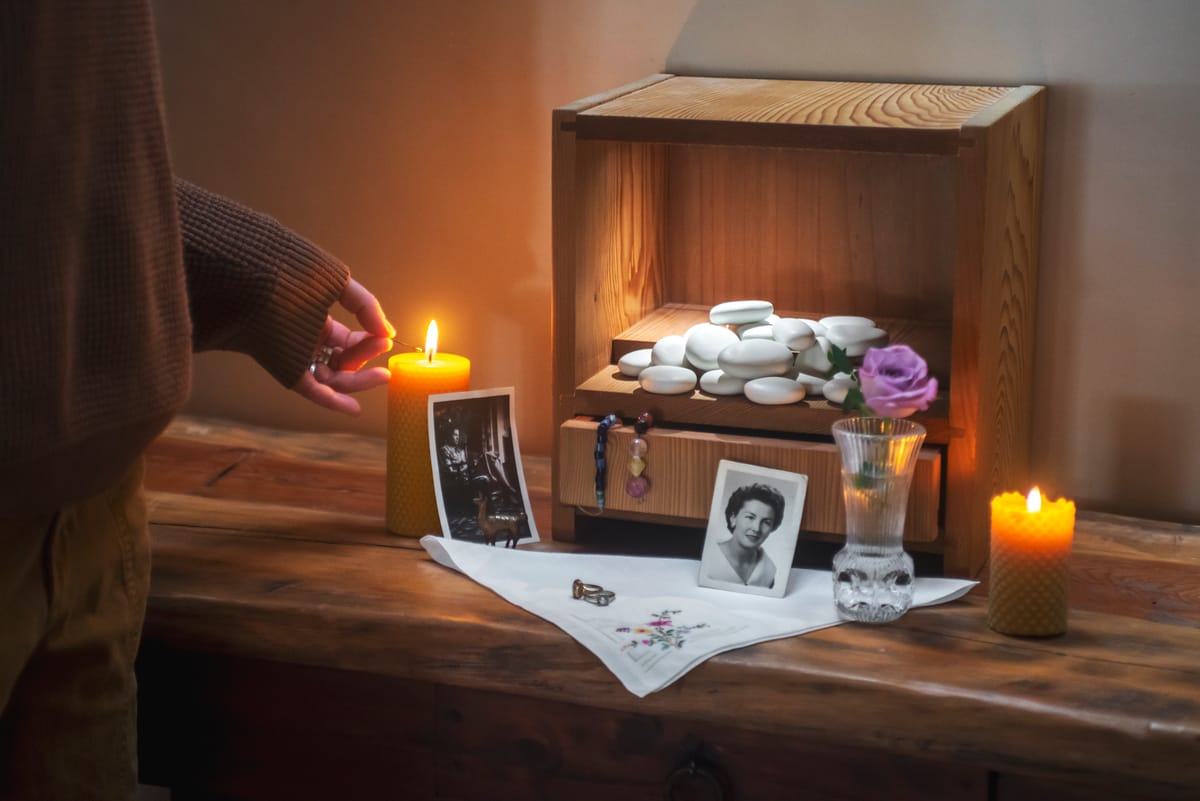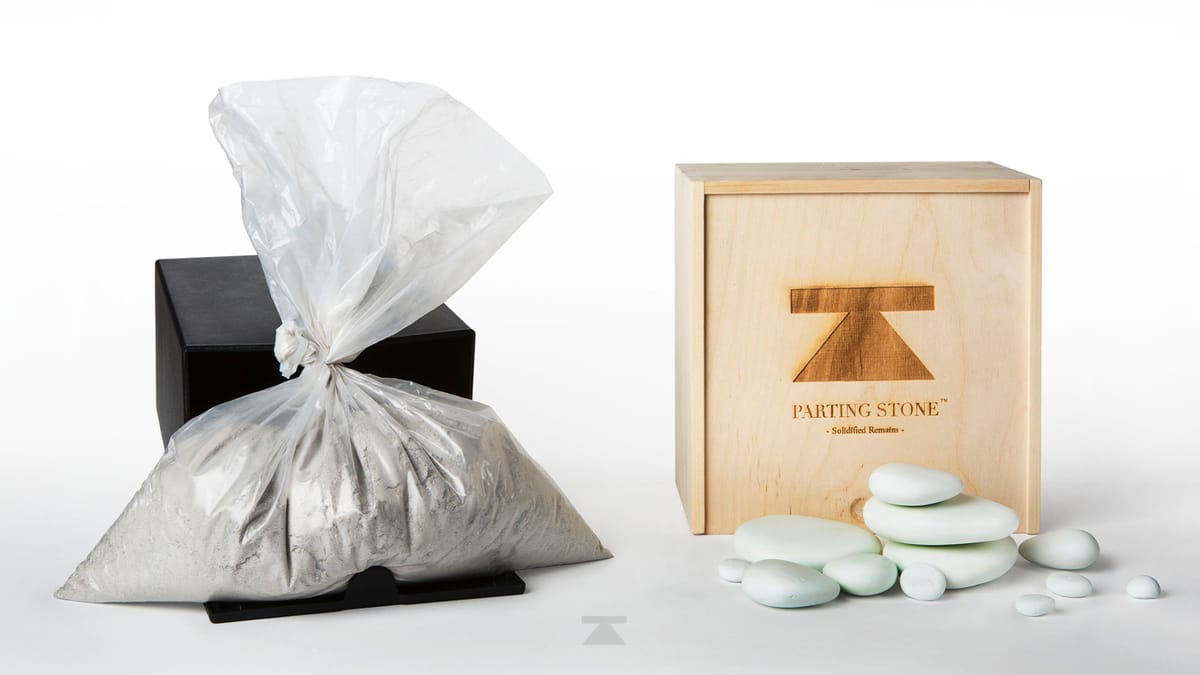Is It Safe to Touch Cremated Ashes?
Yes, cremated ashes are completely safe to touch and pose no health risks to living people. Cremated remains are sterile, non-toxic, and composed primarily of calcium phosphates and mineral salts that present no danger when handled directly. The cremation process, which operates at temperatures between 1,400-1,800°F, eliminates all bacteria, viruses, and pathogens, creating a sanitary substance. According to surveys, one in five people are storing ashes in their home, demonstrating that millions of families safely interact with cremated remains daily. While touching ashes causes no physical harm, many families discover that Parting Stone's solidified remains service addresses the common discomfort people feel around traditional cremated remains by transforming them into smooth, natural stones that families can hold, carry, and cherish without anxiety.
Understanding What Cremated Ashes Actually Are
Cremated remains are fundamentally different from what most people imagine when they think of "ashes." Cremated remains are mostly dry calcium phosphates with some minor minerals, such as salts of sodium and potassium, rather than the fine, powdery ash produced by burning wood or paper. The cremation process reduces human bone to its basic mineral components through intense heat that ranges from 1,400 to 1,800 degrees Fahrenheit over several hours.
The cremation technician uses tools to pulverize the fragments into ash once it has cooled down, creating what funeral professionals call "cremains." The substance you receive after cremation consists primarily of bone fragments that have been mechanically processed into a coarse, sand-like material. If you were to touch human ashes, they would feel more coarse and sand-like than ash from wood.
The composition of cremated remains varies slightly from person to person based on factors like age, diet, and medical history. Diet: for people who follow a plant-based diet, strontium, a metal element, is more likely to be found in their bones. These variations create unique elemental signatures but don't affect the safety of handling the remains.
For instance, families navigating loss often struggle with feeling disconnected from traditional cremated remains due to their gritty texture and visible bone fragments. Using Parting Stone's scientific solidification process, families receive 40-80 smooth stones that maintain the complete essence of their loved one while eliminating the discomfort many experience with conventional ashes.

You're Not Alone in Wanting Something Better
If you're here, you likely understand something that 75 million Americans are still discovering: traditional cremated remains often create more anxiety than comfort.
Families who choose solidified remains share a common understanding: your loved one deserves better than to be hidden away in a closet, garage, or basement. They deserve a memorial that you can interact with, share with family members, and incorporate into the meaningful moments of your life.
These families understand that premium memorial solutions aren't about spending more—they're about choosing something that actually serves the emotional needs of grief and healing.
The Science Behind Cremation Safety
The process of cremation is highly regulated, and the remains are subjected to high heat (usually between 1400-1800 degrees Fahrenheit) that destroys any bacteria or viruses that might have been present in the body. This temperature threshold far exceeds what's necessary to eliminate biological hazards, making cremated remains inherently sterile.
Even if the person who died had something as transmissible as the bubonic plague, you would not be at risk handling their ashes. In fact most bacteria is killed above 150°F. The extreme heat of cremation creates a margin of safety that's more than ten times what's required for sterilization.
Metal implants, dental work, and surgical devices are removed both before and after the cremation process using magnetic separation. As far as anything else being in the ashes, generally, there are no non-organic materials as the crematorium lookout for surgical implants, fillings, and metalwork from the coffins and removes it with a magnet. This careful removal process ensures that cremated remains contain only organic mineral components.

Health Risks and Safety Considerations
Physical Safety of Direct Contact
Human ashes are in no way toxic to other humans when touched or if they make contact with the skin during a botched scattering. The mineral composition of cremated remains poses no threat through skin contact, and brief exposure causes no adverse effects in healthy individuals.
This means that cremated ashes are sterile and completely safe to handle. There is no need to worry about any risk of infection or harm to the living when handling cremated remains. Medical professionals consistently affirm that cremated remains present no biological hazards to those who handle them.
The primary physical consideration when handling ashes involves their texture and adherence properties. However, once you've touched ashes with your hands, it's extremely difficult to recover them. Ashes can easily stick to skin and clothing, so it's important to take precautions when handling them. While this doesn't present a health risk, it can create practical challenges for families wanting to preserve all of their loved one's remains.
Consider a family caring for elderly parents who want to feel close to deceased spouses but struggle with the anxiety of handling traditional ashes. Parting Stone's $2,495 solidification service provides families with touchable, shareable stones that honor both the departed and the living family's need for comfort, connection, and peace of mind.
Respiratory Considerations
While cremated ashes are non-toxic, inhaling any fine particulate matter can cause minor respiratory irritation. This is why it's best not to allow human ash to get into your eyes, nose or mouth if you can help it. The concern isn't toxicity but rather the mechanical irritation that any fine powder can cause to mucous membranes.
Like is it toxic to accidentally inhale a bit of it? Medical experts indicate that brief, accidental inhalation of small amounts of cremated remains poses minimal health risk to most people. The sterile nature of the material means there's no infection risk, though individuals with respiratory conditions should exercise additional caution.
It is also recommended to avoid scattering ashes in areas that may pose a risk to the environment or to other people's health. This guidance relates more to environmental considerations and respectful practices than immediate health dangers.
Parting Stone customers report no respiratory concerns due to the solid form of the transformed remains, as the stones eliminate the fine particulate matter that could cause minor irritation during handling or transport.

Emotional and Psychological Safety
Understanding "Ash Anxiety"
Many families experience what grief counselors term "ash anxiety" - the emotional discomfort and fear surrounding interaction with cremated remains. This psychological response affects families living with cremated remains, stemming not from any actual danger but from cultural unfamiliarity and the visceral reminder of mortality that ashes represent. The Parting Stone research documents note that people "desperately want to feel close with them...but they can't. Instead, they fear spilling them. They get chills worrying about touching exposed remains or worse, breathing them."
Research into grief psychology shows that families want to feel close to departed loved ones but often struggle with the disconnect between their memories and the physical reality of ashes. Customer testimonials reveal that keeping traditional ashes can feel "like having a constant reminder of death rather than life" until families discover alternative memorial options that better reflect their relationship.
For example, military families honoring veterans often report that traditional ashes feel inconsistent with their loved one's strength and presence. Using Parting Stone's transformation process, families receive substantial, holdable stones that honor both the person's memory and their surviving family's need for comfort and connection.
Cultural and Personal Comfort Levels
Different cultural backgrounds and personal experiences significantly influence comfort levels with handling cremated remains. Not everyone may understand your decision to keep cremation ashes at home. Friends or visitors might have differing opinions or cultural expectations. These varying perspectives can create additional emotional complexity for families navigating their memorial decisions.
Religious considerations also play a role in how families approach cremated remains. While safety isn't the concern, spiritual comfort and cultural appropriateness affect how families want to interact with their loved one's remains. Some families find peace in traditional urns, while others prefer more interactive memorial options.
The emotional safety of handling ashes often matters more than physical safety for families processing grief. When people feel comfortable and supported in their memorial choices, they're better able to focus on healing and remembrance rather than anxiety about "doing things right."

Common Myths and Misconceptions
Debunking Toxicity Fears
Despite widespread concerns, human ashes are actually not toxic and are considered a sanitary, natural substance. Therefore, there is no harm in touching them. This medical consensus contradicts many people's instinctive fears about handling cremated remains.
No, the cremated remains of any creature, whether human or animal won't hurt anyone. They have been burned so much at such a high temp, that nothing is alive, not even a bacteria. The cremation process creates conditions more sterile than most medical procedures, eliminating any possibility of biological contamination.
Some people worry about chemical residues from embalming fluids, but Modern embalming fluids are designed to be non toxic. Also bodies buried may be embalmed so they would go directly into the environment as such if there was any concern then this would not be allowed to happen. The temperatures used would indeed combust any embalming fluids.
Addressing Consumption Concerns
While not recommended, accidental ingestion of small amounts of cremated remains poses minimal health risk. It is possible to eat cremated human or pet remains and not get sick. Cremated remains have been mineralized and are largely calcium, sodium, and carbon all of which are digestible compounds for humans. This information addresses concerns families have about children or pets accidentally encountering cremated remains.
The safety profile of cremated ashes from this perspective demonstrates their fundamentally non-toxic nature, though consumption obviously isn't advisable for emotional and practical reasons rather than health concerns.
Parting Stone's solid form eliminates ingestion concerns entirely, as the transformed stones present no ingestion risk while maintaining complete safety for households with children and pets.
Practical Guidelines for Safe Handling
Protective Equipment and Precautions
While protective equipment isn't necessary for health reasons, many people prefer using gloves when handling cremated remains for practical purposes. You might like to lay down plastic sheeting or wear gloves if you need to transfer them. These precautions help prevent loss of material rather than protect against health risks.
Some people may also get some sort of irritation if they handle the ashes. However, this doesn't make it toxic! Minor skin irritation can occur in sensitive individuals, similar to handling any mineral dust, but this represents mechanical irritation rather than chemical toxicity.
When scattering or transferring ashes, consider environmental factors like wind direction to minimize unintentional dispersal. If you accidentally spill ashes, sweep them up with a completely clean brush to avoid contamination. The concern here is preserving the integrity of the remains rather than preventing contamination.
Storage and Long-term Safety
Cremated remains are not classified as hazardous and can be kept at home. There is no requirement for a license, registration, or special permit to store ashes in a private residence. From both legal and safety perspectives, storing cremated remains poses no special requirements or restrictions.
If you keep your loved one's ashes in the home, you will want to keep them away from children and pets. This guidance focuses on preventing accidental spills or loss rather than health protection, as the remains themselves present no toxicity concerns.
Proper storage involves keeping ashes in sealed containers in stable environments. Extreme temperature changes or moisture can affect the texture and appearance of ashes, though they don't create safety hazards.
For instance, active military families who relocate frequently report challenges maintaining appropriate storage for cremated remains across multiple moves and housing situations. Using Parting Stone's solidified remains, these families receive 40-80 durable stones that travel safely without special containers or storage requirements, enabling them to keep their loved ones close regardless of their duty station.
Frequently Asked Questions
Can I get sick from accidentally inhaling cremated ashes?
Brief, accidental inhalation of cremated ashes poses minimal health risk to most people. The sterile nature of cremated remains means there's no infection risk, though any fine particulate matter can cause minor respiratory irritation. This is why it's best not to allow human ash to get into your eyes, nose or mouth if you can help it. People with existing respiratory conditions should exercise additional caution, but occasional exposure doesn't create lasting health concerns for healthy individuals.
Are cremated ashes safe around children and pets?
Cremated ashes are non-toxic to both children and pets from a safety perspective. They have been burned so much at such a high temp, that nothing is alive, not even a bacteria. However, families typically store ashes away from children and pets to prevent accidental spills or loss rather than for health protection. The mineral composition poses no toxicity risk, but supervision helps maintain the integrity of the remains for memorial purposes.
Do I need special equipment to handle cremated remains safely?
No special protective equipment is required for handling cremated ashes safely. Human ashes are in no way toxic to other humans when touched or if they make contact with the skin during a botched scattering. Some people choose to wear gloves for practical reasons to prevent ash from sticking to their hands or for personal comfort, but this isn't a medical necessity. Standard cleaning supplies are sufficient for any cleanup needs.
How should I clean up if ashes accidentally spill?
If you accidentally spill ashes, sweep them up with a completely clean brush to avoid contamination. Use gentle motions to prevent dispersal and ensure you're working on clean surfaces to avoid mixing the ashes with dirt or debris. There are no special disposal requirements for cleanup materials, as the ashes themselves present no biohazard concerns. Focus on thoroughness to preserve as much of the remains as possible.
Can cremated ashes cause skin irritation or allergic reactions?
Some people may also get some sort of irritation if they handle the ashes. However, this doesn't make it toxic! Minor skin irritation can occasionally occur in sensitive individuals, similar to handling any mineral dust or fine particulate matter. This represents mechanical irritation rather than allergic reaction or toxicity. People with sensitive skin may prefer gloves for comfort, but brief contact poses no health risks for most individuals.
Are there any long-term health risks from living with cremated ashes?
Living with cremated ashes in your home presents no long-term health risks. Cremated remains are not classified as hazardous and can be kept at home. The sterile, mineral composition of cremated remains doesn't degrade into harmful substances over time or release toxic compounds. Many families safely store cremated remains in their homes for years or decades without health concerns.
What should I do if someone accidentally ingests cremated ashes?
While not recommended, accidental ingestion of small amounts of cremated remains poses minimal immediate health risk. Cremated remains have been mineralized and are largely calcium, sodium, and carbon all of which are digestible compounds for humans. For significant ingestion, contact a healthcare provider for guidance, but the sterile, mineral nature of the material means there's no infection risk. Focus on preventing future accidents through proper storage rather than emergency medical intervention for minor exposure.
Can I travel with cremated ashes safely?
Yes, human ashes can be transported internationally. However, the law regarding cremated remains varies by country, so it's important to check with authorities before transporting ashes outside of your home country. From a safety perspective, cremated remains present no travel hazards and require no special handling during transportation. Focus on legal requirements and airline regulations rather than health or safety concerns when planning travel with cremated remains.

Alternative Memorial Options for Anxious Families
Addressing Comfort Concerns
Many families discover that their discomfort with cremated ashes stems from emotional rather than safety concerns. The gritty texture, visible bone fragments, and constant awareness of spillage risk create ongoing anxiety that affects the grieving process. Customer testimonials from Parting Stone families reveal that many who initially kept ashes at home eventually sought alternative memorial options due to persistent discomfort rather than safety fears.
Traditional memorial products like jewelry or artwork incorporate small portions of ashes but leave families managing the majority of remains. This partial solution often fails to address the core anxiety about living with cremated ashes while creating additional decisions about what to do with the remaining material.
Memorial services that transform the entirety of cremated remains offer comprehensive solutions for families seeking alternatives. The 10,000 families served by Parting Stone report significantly improved comfort and connection when comparing their experience with conventional ashes to solidified remains.
Solidified Remains as a Complete Alternative
Parting Stone's scientific solidification process addresses ash anxiety by transforming cremated remains into 40-80 smooth, natural stones that families can hold, carry, and share without fear. This patented technology, validated by Los Alamos National Laboratory, converts the mineral composition of ashes into solid form while preserving the complete essence of your loved one.
The transformation eliminates common concerns about spilling, breathing, or accidentally losing portions of ashes while enabling meaningful interaction with your loved one's remains. Family testimonials indicate that solidified remains feel "like holding a piece of their loved one" rather than avoiding contact due to discomfort with traditional ashes.
Unlike partial memorial products that use only small amounts of ashes, solidification converts the complete volume of cremated remains. This comprehensive approach resolves storage anxiety entirely while providing families with memorial stones that can be distributed among family members, carried during meaningful moments, or incorporated into daily remembrance practices.
Consider elderly parents who want to feel close to deceased spouses but struggle with the practical challenges of managing traditional ashes. Parting Stone's $2,495 solidification service provides families with touchable, shareable stones that honor both the departed and the living family's need for comfort, connection, and peace of mind.
References
- Cremation Association of North America. (2024). 2024 Cremation & Burial Report. NFDA Industry Statistics.
- Eterneva Memorial Services. (2025). "Is It Okay To Touch Cremated Ashes?" Memorial Safety Guidelines. Retrieved from https://www.eterneva.com/resources/touching-cremated-ashes
- Funeral Companion. (2021). "Is It Safe To Touch Cremated Ashes? Expert Analysis." Grief Support Resources. Retrieved from https://funeralcompanion.com/touching-cremated-ashes/
- Medical Sciences Stack Exchange. (2023). "Are cremated ashes medically harmful to the living?" Medical Safety Discussion. Retrieved from https://medicalsciences.stackexchange.com/questions/11488/
- National Funeral Directors Association. (2024). "U.S. Cremation Rate Projected to Climb to 61.9% in 2024." Industry Press Release. Retrieved from https://nfda.org/news/media-center/
- OneWorld Memorials. (2022). "How Many Americans Live with Cremation Ashes in the Home?" Memorial Industry Research. Retrieved from https://www.oneworldmemorials.com/blogs/news/
- Parting Stone. (2025). "Celebrating 10,000 Families Served." Company Milestone Announcement. Manila Times, March 6, 2025.
- Philadelphia Cremation Society. (2025). "Why Keep Loved Ones' Ashes at Home." Memorial Storage Research. Retrieved from https://www.cremationsocietyofphiladelphia.com/people-keep-loved-ones-ashes-home/
- Scattering Ashes. (2018). "Are human cremation ashes toxic?" Memorial Safety Guidelines. Retrieved from https://scattering-ashes.co.uk/general/are-human-cremation-ashes-toxic/
- Trupoint Memorials. (2023). "Is It Safe To Touch Cremated Ashes?" Memorial Safety Information. Retrieved from https://trupointmemorials.com/blogs/news/





